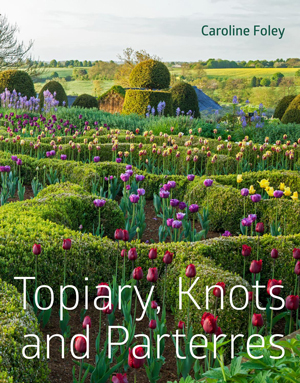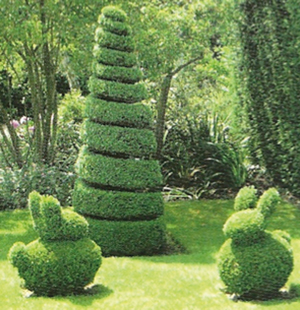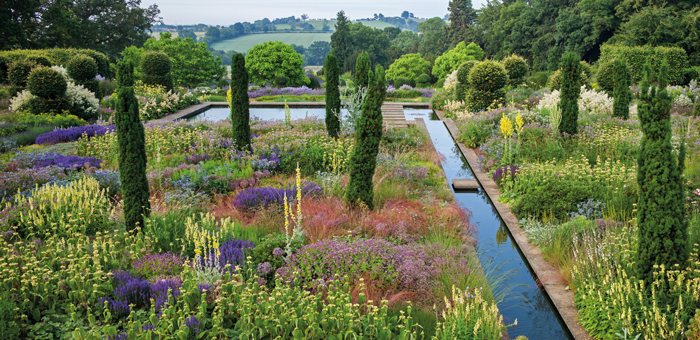Topiary, Knots and Parterres
Sandy Felton reviews Caroline Foley’s new book to discover the history of topiary from the Romans to Tom Stuart-Smith.
I first fell in love with topiary as a child when I was taken on a visit to Levens Hall in Cumbria. Those towering boxwood figures cut in strange shapes, the tall hedges and the Great Umbrella tree, all amazed me and sowed a seed that was to grow as I did.
 In her new book, ‘Topiary, Knots and Parterres‘, Caroline Foley traces the history of topiary from the grand and imposing to the humble and folksy. She admits that her aim is to, “knock topiary off its perch as the grandee of garden techniques and to explode any false mystique surrounding it as an exclusive type of gardening.” She points out that it deserves to be in every gardener’s box of tricks and the techniques at the disposal of every horticultural student and I couldn’t agree more.
In her new book, ‘Topiary, Knots and Parterres‘, Caroline Foley traces the history of topiary from the grand and imposing to the humble and folksy. She admits that her aim is to, “knock topiary off its perch as the grandee of garden techniques and to explode any false mystique surrounding it as an exclusive type of gardening.” She points out that it deserves to be in every gardener’s box of tricks and the techniques at the disposal of every horticultural student and I couldn’t agree more.
When I was much older I visited Hidcote and if I needed any encouragement for topiary I could not have visited a better place. It was after that visit that I actually made a determined effort to ‘put some box’ into my own garden. Minimal though it is I call it my ‘bit of Hidcote’.
The first mention of topiary was made by Pliny the Younger in the 1st century AD when he wrote a letter to his friend proudly describing his boxwood figures ‘cut in the shape of animals’ in his villa. From these beginnings we are taken on a journey through the paradise gardens of Islam, the medieval hortus conclusus and the formal parterres of Renaissance Italy to the more elaborate broderies of the royal French gardens.
I found, what Caroline refers to as the conceits of the Tudors and the geometry of the Dutch School, fascinating before moving onto the 18th century, when many fine gardens were scrapped in favour of the English landscape movement. Fortunately, gardens such as Levens Hall escaped this movement so we are fortunate today to still be able to enjoy its wonderful topiary and very lucky for me that I live so close.
 We then move to a chapter covering the Swan Song of the Formal Garden and onto The Landscape Movement before taking a look at The Victorian Garden and the Arts and Crafts Movement.
We then move to a chapter covering the Swan Song of the Formal Garden and onto The Landscape Movement before taking a look at The Victorian Garden and the Arts and Crafts Movement.
In the 19th century we see the joyful resurgence of the topiary peacock and other such ‘conceits’ before moving onto the arrival of the Japanese minimalist school and of course cloud pruning.
The reader then discovers the rhythmic swirling patterns of Roberto Burle-Marx parterres, the resurgence of the maze in the 1980s and the rich carpet perennial planting of designers such as Tom Stuart-Smith, often beautifully set off by the formality of topiary.
This carefully researched and entertaining book will be valuable not only to gardeners and those with an interest in garden development and history it will also provide an excellent research book for students of horticulture and landscape as it is the first book to cover the entire history of this subject from the Romans to Jacques Wirtz and Tom Stuart-Smith.
It is packed with information, diagrams and photographs from a wide variety of sources and written in a lively style. I particularly enjoyed the chapter on the Arts and Crafts Movement with its return of green architecture and references to Great Dixter, Hidcote Manor and Sissinghurst Castle. There are plenty of references throughout the book to relevant gardens and the author has enlisted the aid of a wide variety diarists, writers, wits, designers and gardeners to trace this fascinating history throughout the centuries.
Owlpen Manor
The book is superbly illustrated and obviously I was delighted to see the venerable Jacobean topiary garden at Levens Hall, on the half-title page.Tom Stuart-Smith’s stunning design at Broughton Grange (pictured below) is superbly captured by Andrew Lawson.
As Caroline points out whether serious or frivolous, topiary always has character and presence. It can be immaculate or possess poetry and possibly even greater charm when it is overblown and blowsy with age. Either way, it will always be a win-win proposition.
Broughton Grange
Caroline is the author of numerous books, among them three bestsellers including ‘Of Cabbages and Kings: The History of Allotments’ (2014). She has been the editor of ‘Topiarius’, the pan-European Journal of the European Boxwood and Topiary Society for the past 12 years.
‘Topiary, Knots and Parterres’ by Caroline Foley is published by Pimpernel Press Limited – www.pimpernelpress.com – in association with The European Boxwood and Topiary Society. It is a coffee table book in hardback published June 2017 price £50.00.
Picture credits: Topiary right (rabbits) and Owlpen Manor (centre) ©Caroline Foley; Broughton Grange bottom above ©Andrew Lawson.




